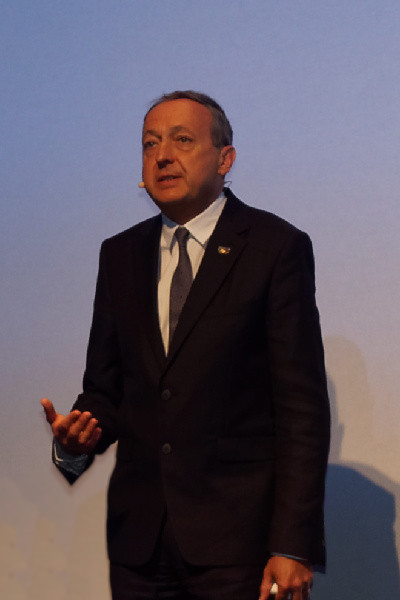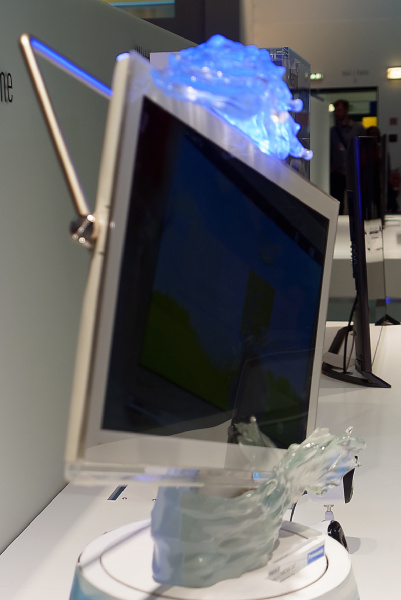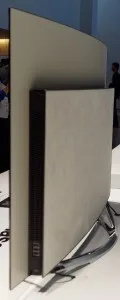 The Panasonic press event took place in part of its (large) booth. The first speaker was the Panasonic Europe Chairman and CEO, Laurent Abadie and he said that Panasonic’s focus is on “smarter living” and he showed a video of “life in 2020”. Next he turned to Panasonic’s turn around to profitability.
The Panasonic press event took place in part of its (large) booth. The first speaker was the Panasonic Europe Chairman and CEO, Laurent Abadie and he said that Panasonic’s focus is on “smarter living” and he showed a video of “life in 2020”. Next he turned to Panasonic’s turn around to profitability.
Nubo is claimed to be the first 4G monitoring camera that doesn’t need Wi-Fi (it uses 4G and also uses 3G & 2G) and can warn you when someone is in a visible area that you have nominated for security applications. Abadie announced a partnership with Allianz for home security. Allianz has a special kit of sensors and assistance services (Allianz Assist) to back up the technology.
Panasonic has invested a lot in batteries and is introducing a storage battery for homes and the company sees a big potential for the market – it is identified as one of the main growth areas for Panasonic in the future. The company is growing its presence in home appliances and is still on plan to sell €17 billion per year in electronics in Europe in the future. The company has core competencies in environmental areas, digital AV and cloud computing, materials and devices, sensors and biology and chemistry. On top of this, Panasonic wants to design clean and elegant products.
The firm wants to deliver “aspirational living spaces” rather than just products and that means developing solutions. So the aim is to offer “devices, design and space” – and there was an excruciating video to demonstrate the need for “aspirational products”.
After cooking, fridges and skin care, the company started to talk about 4K. 30fps 8 megapixel images can be captured with its latest cameras and, as we have reported before, Panasonic believes that this will transform still photography, allowing video-like capture and image selection later. Technology has been developed to offer “post capture focus” to some of its cameras.

The CX800 and CX850 TVs shipped this year, with the Firefox OS and UltraHD resolution and Tetsuro Homma said that the Firefox experience makes the smart TVs much better.
Panasonic said that it uses professional level colour correction in its TV processor. The company has 8000 points in its colour LUTs compared to 100 for most consumer TVs – technology that’s in its processor chip (the 4K Studio Master Pro chip).
A video showed Panasonic and independent colour specialists from Hollywood explaining the importance of colour in films and how Panasonic works to deliver what colourists want to see. Mike Sowa, a colourist from Hollywood, then came on to explain how a colourist works – typically over three to seven weeks for a Hollywood movie, correcting and optimising colour down to the individual frame level, if necessary. He said that the Panasonic 4K Pro TVs are now up to the level that he has been looking for for a long time. He believes that the top Panasonic TVs are at a “reference monitor” level performance.
The CZ 950 is the first commercial 4K TV based on OLED that Panasonic has developed. It has the 4K Studio Master Pro chip, has been awarded the THX certification for TV and is “HDR compatible”. The 65″ OLED is curved and is designed to fit well visually into customer’s rooms and has an “Alcantra” back surface and the TV will go on sale from October. Homma said that Panasonic was able use experience from its PDP developments to improve the driving of OLED displays.
Michiko Ogawa runs the Technics business that Panasonic re-introduced last year. The range has been extended this year and the company has re-introduced a direct drive turntable.
Booth Tour
 Panasonic curved OLED has lots of circuitry on the backThe OLED TV from Panasonic was the highlight of the booth, and performance certainly looked very good. We confirmed with LG Display, separately, that Panasonic (along with other independent companies) had been very helpful in the development of the OLED driving schemes. (LG Display uses a simpler transistor structure than Samsung for its OLEDs and that means that a lot of the compensation has to be done off the panel, which is a challenge – Man. Ed.) We were surprised to see that there is a big box of electronics on the back of the Panasonic OLED TV that took away some of the appeal of the “slimness”. The TV has HDR support and Panasonic quotes support for the ST2084 (‘Dolby’ PQ EOTF) and ST2086 (static metadata) SMPTE Standards. Power consumption is 214W and the unit has dual DVB-T2, S2 and C tuners as well as Sat>IP compatibility. The press release said that the set supports passive 3D and glasses are available, although nobody on the booth was talking about this. The set has dual CI slots, which means it should be able to cope with some of the challenges in Pay TV, e.g. in Italy.
Panasonic curved OLED has lots of circuitry on the backThe OLED TV from Panasonic was the highlight of the booth, and performance certainly looked very good. We confirmed with LG Display, separately, that Panasonic (along with other independent companies) had been very helpful in the development of the OLED driving schemes. (LG Display uses a simpler transistor structure than Samsung for its OLEDs and that means that a lot of the compensation has to be done off the panel, which is a challenge – Man. Ed.) We were surprised to see that there is a big box of electronics on the back of the Panasonic OLED TV that took away some of the appeal of the “slimness”. The TV has HDR support and Panasonic quotes support for the ST2084 (‘Dolby’ PQ EOTF) and ST2086 (static metadata) SMPTE Standards. Power consumption is 214W and the unit has dual DVB-T2, S2 and C tuners as well as Sat>IP compatibility. The press release said that the set supports passive 3D and glasses are available, although nobody on the booth was talking about this. The set has dual CI slots, which means it should be able to cope with some of the challenges in Pay TV, e.g. in Italy.
The TX-65CZ950 will start to ship in October, we heard, although the German release suggests November.
Panasonic was highlighting its 4K Pro technology, available on the high end sets, with demos of the better performance of its TV sets. Panasonic said it has a number of new sets including curved units, but these seem to be units that have already been announced and released.
As you would expect, Panasonic had a prototype UltraHD Blu-ray player, but there were no details and shipment probably won’t happen until early 2016 – but there won’t be content until then, anyway, we hear.
On the booth were a couple of small (15″/24″) Primova TVs. These are completely waterproof and can offer up to 3.5 hours use from a battery. The products were being shown to assess interest – they are still “under development” in Europe, although apparently on the market in Japan.
 Panasonic’s portable TV is on sale in Japan and is waterproof
Panasonic’s portable TV is on sale in Japan and is waterproof
Panasonic was also highlighting its support of SAT>IP technology, which allows streaming of satellite content around a home network. This initiative has been developed and promoted by SES and Panasonic has sets that can act as clients or servers.
Analyst Comment
We were talking to an analyst from another research company on the booth and he said that Panasonic might find it difficult to sell the set at the price which he expected to be €6,000 to €7,000. We later heard that Panasonic has set a price of €9,999 so sales may be “vanishingly small”! However, we have a huge respect for the “acceptable image quality” standards that Panasonic sets have. (BR)

